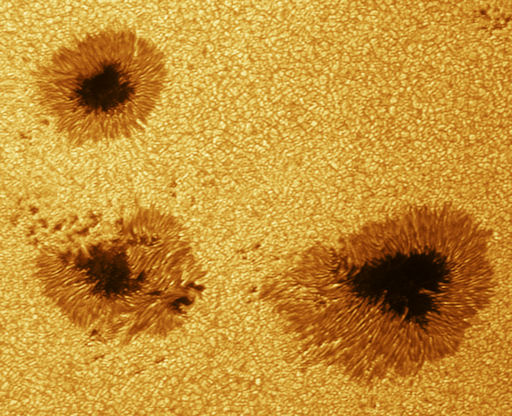Hang the Transit of Venus on your wall! Hubble-quality images from NASA's Solar Dynamics Observatory are now available as metallic posters in the Space Weather Store. | | |
CHINESE SPACE TRANSIT: China's space program took another leap forward this week when Chinese astronauts onboard the Shenzhou 9 spacecraft successfully docked with the Tiangong 1 space station. Not long after the docking, which occured on Monday, June 18th, the joined craft passed directly in front of the sun over Xinzhou, China, where amateur astronomer Su Shaojie recorded the split-second transit:

"After the Shengzhou 9 successfully docked with Tiangong-1 at 14:07 Beijing time, I was happy to get this opportunity to take a picture of the two spaceship transiting the Sun," says Shaojie. "I used CalSky to predict the timing."
The mission's crew of three includes the first Chinese female astronaut, fighter pilot Liu Yang, 33. Yang, along with fellow taikonauts Commander Jing Haipeng, 46, and flight engineer, Liu Wang, 42, will spend the days ahead familiarizing themselves with their new space station, conducting scientific experiments, and practicing space dock procedures. They're expected to return to Earth before the end of the month.
The newly-manned Tiangong 1 is visible in the night sky, glowing about as brightly as a 1st magnitude star. Check the Simple Satellite Tracker or your smartphone for sighting opportunities.
TRIPLE SUNSPOT: Sunspot 1504, the source of many auroras on June 16th and 17th, is decaying. Nevertheless, the behemoth is still an easy target for backyard solar telescopes. Amateur astronomer François Emond sends this picture from Chorges in the French Alps:

The dark cores in Emond's image are about twice the size of Earth. Floating in a sea of hot plasma, these vast islands of magnetism are surrounded by boiling granules big enough to swallow Texas.
It should come as no surprise that such a structure, while decaying, still poses a threat for explosions. NOAA forecasters estimate a 25% chance of M-class fllares during the next 24 hours. X-flare alerts: text, voice.
Realtime Space Weather Photo Gallery
FIRE LIT BY THE TRANSIT OF VENUS: Around the world on June 5th and 6th, millions of people watched the Transit of Venus. Only one man used it to light a candle. Christopher Handler of Adelaide, South Australia, explains how it was done: "The flame that burns in this lantern was lit with photons of light, of which about 0.001% had skipped through the atmosphere of another planet." (continued below)

"While watching the transit with my wife and son, I began to write words on a piece of wood with a magnifying glass, while explaining to my son that some of the sunshine we were using had bounced off the clouds of Venus only minutes earlier. Before long, we had lit a small fire in some kindling and from that lit several candles around the house. The hours passed by and the transit was over, yet we still have the flame. Captivated by the thought that it will take another 105 years before it could be done on Earth again, I feel almost compelled to keep it alight, even now, many days later."
A thousand more unique photos of the event may be found in the Transit of Venus gallery. Note: When you're browsing the gallery, please vote for your favorite images. We'll be creating a gallery of the most popular shots--and your votes count.

